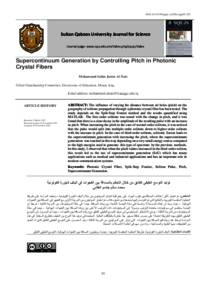Document
Supercontinuum generation by controlling pitch in photonic crystal fibers.
Identifier
DOI:10.53539/squjs.vol29iss1pp95-102
Source
Sultan Qaboos University Journal for Scientific. v. 28, no. 1, p. 95-102.
Other titles
توليد التوسع الطيفي الفائق من خلال التحكم بالمسافة بين الفجوات في الياف البلورة الفوتونية.
Country
Oman
City
Muscat.
Publisher
College of Science, Sultan Qaboos University.
Gregorian
2024-04-24
Language
English
Subject
English abstract
The influence of varying the distance between air holes (pitch) on the geography of solitone propagation through a photonic crystal fiber has been tested. The study depends on the Split-Step Fourier method and the results quantified using MATLAB. The first-order solitone was tested with the change in pitch, and it was found that there is a clear decay in the amplitude of the resulting pulse with an increase in pitch. When increasing the pitch in the case of second-order solitons, it was noticed that the pulse would split into multiple-order solitons down to higher-order solitons with the increase in pitch. In the case of third-order solitons, solitonic fission leads to the supercontinuum generation with increasing the pitch, where the supercontinuum generation was reached in this way depending on a very small energy source compared to the high energies used to generate this type of spectrum by the previous methods. In this study, I observed that when the pitch values increased in the third-order soliton, this result led to the use of supercontinuum generation (ScG) which has many applications such as medical and industrial applications and has an important role in modern communication systems.
ISSN
2414-536X
Arabic abstract
تم اختبار تأثير اختلاف المسافة بين فتحات الهواء (الملعب) على جغرافية انتشار السوليتون من خلال الألياف البلورية الضوئية. تعتمد الدراسة على طريقة Split-Step Fourier وتم قياس النتائج باستخدام MATLAB. تم اختبار السوليتون من الدرجة الأولى مع تغير درجة الصوت، وتبين أن هناك اضمحلال واضح في سعة النبض الناتج مع زيادة درجة الصوت. عند زيادة طبقة الصوت في حالة سليتونات من الدرجة الثانية، لوحظ أن النبض سوف ينقسم إلى سليتونات متعددة الرتب نزولاً إلى سليتونات ذات رتبة أعلى مع زيادة طبقة الصوت. وفي حالة السوليتونات من الدرجة الثالثة يؤدي الانشطار السوليتوني إلى توليد سلسلة فائقة الاستمرارية مع زيادة طبقة الصوت، حيث تم الوصول إلى توليد السلسلة الفائقة بهذه الطريقة بالاعتماد على مصدر طاقة صغير جداً مقارنة بالطاقات العالية المستخدمة لتوليد هذا النوع من الطيف بواسطة الطرق السابقة . لاحظت في هذه الدراسة أنه عندما زادت قيم طبقة الصوت في سوليتون من الدرجة الثالثة أدت هذه النتيجة إلى استخدام توليد الاستمرارية الفائقة (ScG) الذي له العديد من التطبيقات مثل التطبيقات الطبية والصناعية وله دور مهم في أنظمة الاتصالات الحديثة .
Category
Journal articles

